The Third Secret Controversy
The Third Secret Controversy—Part I
In recent years a controversy has been raging concerning what is commonly known as the "Third Fatima Secret." The focus of this controversy is the allegation that the Vatican has been conducting a cover-up of the true contents of the Third Secret and attempting to misinterpret the Message of Our Lady of Fatima. Before going into the details of this controversy, it is well worth the time to review the history and background of the Third Secret.
A Secret of "Three Distinct Parts"
It was during the third apparition of the Blessed Virgin Mary to the three children, Lucia dos Santos, Jacinta and Francisco Marto, on July 13th, 1917, that Our Lady revealed the "Great Secret." The fact that there was a Secret of immense importance became so well known, that in the following month, the children were apprehended by a local government administrator, in order to force them to reveal the Secret and prevent them from continuing to receive the apparitions of Our Lady. The children refused to reveal the Secret, even though the administrator threatened them with death.
It was not until 1941, that it became publicly known that the Secret was made up of "three distinct parts." In her Third Memoir, dated August 31, 1941, Sr. Lucia wrote, in obedience to her Bishop: "...the Secret is made up of three distinct parts, two of which I am now going to reveal. The first part is the vision of Hell… The second part refers to the devotion to the Immaculate Heart of Mary."

The First and Second Parts of the Secret
Sr. Lucia was ordered by her Bishop to amplify what she had written already. In her Fourth Memoir, dated December 8, 1941, Sr. Lucia gave the most detailed account of the first two parts of the Secret:
"Sacrifice yourselves for sinners, and say many times, especially whenever you make some sacrifice: O My Jesus, it is for love of Thee, for the conversion of sinners, and in reparation for the sins committed against the Immaculate Heart of Mary."
As Our Lady spoke these last words, She opened Her hands once more, as She had done during the two previous months. The rays of light seemed to penetrate the earth, and we saw as it were a sea of fire. Plunged in this fire were demons and souls in human form, like transparent burning embers, all blackened or burnished bronze, floating about in the conflagration, now raised into the air by the flames that issued from within themselves together with great clouds of smoke, now falling back on every side like sparks in huge fires, without weight or equilibrium, amid shrieks and groans of despair, which horrified us and made us tremble with fear… The demons could be distinguished by their terrifying and repellent likeness to frightful and unknown animals, black and transparent like burning coals. Terrified and as if to plead for help, we looked up at Our Lady, who said to us, so kindly and so sadly:
"Here you have seen Hell, where the souls of poor sinners go. To save them, God wishes to establish in the world devotion to My Immaculate Heart. If what I say to you is done, many souls will be saved and there will be peace. The war is going to end; but if people do not cease offending God, a worse one will break out during the pontificate of Pius XI. When you see a night illumined by an unknown light, know that this is the great sign given you by God that He is about to punish the world for its crimes, by means of war, famine, and persecutions of the Church and of the Holy Father.
"To prevent this, I shall come to ask for the consecration of Russia to My Immaculate Heart, and the Communion of Reparation on the First Saturdays. If My requests are heeded, Russia will be converted, and there will be peace; if not, she will spread her errors throughout the world, causing wars and persecutions of the Church. The good will be martyred, the Holy Father will have much to suffer, various nations will be annihilated. In the end, My Immaculate Heart will triumph. The Holy Father will consecrate Russia to Me, and she will be converted, and a period of peace will be granted to the world. In Portugal, the dogma of the Faith will always be preserved; etc. Do not tell this to anybody. Francisco, yes, you may tell him.
"When you pray the Rosary, say after each mystery: O my Jesus, forgive us our sins, save us from the fires of Hell. Lead all souls to Heaven, especially those who are most in need of Thy mercy."
In 1946 several historians of Fatima were able to secure more precise information on certain important points from Sr. Lucia:
Q. "When did you receive from Heaven permission to disclose the Secret?"
A. "In 1927, here at Tuy, in the chapel; but the permission did not apply to the third part of the Secret."
Q. "Have you spoken of it, then, to your Father Confessor?"
A. "Yes—at once."
Q. "What did he say?"
A. "He commanded me to write the Secret—except the third part. I think he did not read it. He gave it back to me. Shortly after I had another Spiritual Director who ordered me to burn it; after which he ordered me to write it again!"
Sr. Lucia smiled while recalling these episodes.
Q. "It seems regrettable that the secret was not published before the war?"
A. "That would have appeared regrettable indeed if the Good God had wanted to present me to the world as a prophetess; but I believe that was not His intention. Moreover, I think that in 1917 He could have commanded me to speak, whereas He commanded me to keep silent, and His order has been confirmed by His representatives. I think then… that God did not want to make use of me except to remind the world of the necessity of avoiding sin and of making reparation for offences against God by prayer and penance. Besides… I would, perhaps, have spoiled God's work. Silence has been for me a great grace. I thank the Good God for it; and I find that everything He does is well done!"
Q. "When writing the Secret, have you quoted literally the words of the Blessed Virgin?"
A. "Yes; when I write, I try to quote literally. I have then wished to write the Secret, word for word."
Q. "Are you sure you have recounted all of it?"
A. "I think so, and I have written the words in the same order as that in which they were said."
Q. "Did the Blessed Virgin really mention the name of Pius XI?"
A. "Yes. We did not then know if he were a Pope or a king; but the Blessed Virgin spoke of Pius XI."
Q. "But the war did not begin during the reign of Pius XI?"
A. "The annexation of Austria was the decisive cause. When the Treaty of Munich was concluded, my (religious) sisters rejoiced saying that peace had been preserved. Alas! I knew better!"
Q. "This 'strange light' on the night of 25th-26th January, 1938, astronomers call the Aurora Borealis. What do you think of it?"
A. "I think that if they examined the thing well, they would have perceived that, taking into the account the circumstances under which this light appeared, it was not and could not have been an Aurora Borealis."
Q. "In the Secret the Blessed Virgin says: 'To prevent this, I shall come to ask for the consecration of Russia, etc.' Did She come?"
A. "Yes, She came into my room on December 10th, 1925, with the Infant Jesus, asking for the five First Saturdays of the month… Then in 1929, in the chapel at Tuy, She asked for the consecration of Russia."
Q. "At what actual stage are we of the period mentioned in the Secret?"
A. "I think that you are at the period when false doctrine shall propagate its errors throughout the world" (More About Fatima, Fr. Montes de Oca).
The Third Part of the Secret
In her published Memoirs, Sr. Lucia wrote nothing distinctly revealing the third part of the Secret. It simply remained a secret. In October of 1943, however, after Sr. Lucia had recovered from a serious illness, she was commanded by her Bishop (who feared that the third part of the Secret might die with her) to commit it to writing. Sr. Lucia said of this event: "They have ordered me to write down the part of the Secret that Our Lady revealed in 1917, and which I still keep hidden by command of the Lord. They tell me either to write it in the notebooks in which I've been told to keep my spiritual diary, or if I wish, to write it on a sheet of paper, put it in an envelope, close it and seal it up" (La verdad sobre el Secreto de Fatima, Fr. Joaquín Alonso).
Sr. Lucia tried to obey, but felt herself impeded by causes which were, in her words, "not natural." Finally Our Lady appeared to her again and gave her the strength to comply with the Bishop's command. On January 9 of 1944, Sr. Lucia wrote to her Bishop: "I have written what you asked me; God willed to try me a little, but finally, this was indeed His will: it (the third part of the Secret) is sealed in an envelope and it is in the notebooks…" (Ibid.) From this statement, many infer that Sr. Lucia wrote two documents: one in a sealed envelope, and another in her personal notebooks.
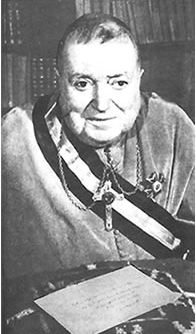
Sr. Lucia sent the sealed envelope to her Bishop (Bishop da Silva of Leiria, Portugal) on June 17 of the same year. Upon the sealed envelope, Sr. Lucia had written: By express order of Our Lady, this envelope can only be opened in 1960 by the Cardinal Patriarch of Lisbon or the Bishop of Leiria. She also requested of Bishop da Silva that the sealed envelope "would definitely be opened and read to the world either at her death or in 1960, whichever would come first" (Ibid.) Two years later, when asked by Canon Barthas the reason for this date, she replied: "Because Our Lady wishes it so" (Fatima, Marveille du XXe Siècle, Canon Barthas).
Later Bishop da Silva placed that envelope in a sealed envelope of his own with the inscription: This envelope with its contents shall be entrusted to His Eminence Cardinal D. Manuel, Patriarch of Lisbon, after my death. However, this never happened; instead, for reasons never fully disclosed, orders came from Rome to deliver the envelope to the papal nuncio, along with the notebooks of Sr. Lucia and photocopies of all her writings on file in the chancery of Leiria. This was accomplished on March 16, 1957, and all these documents were delivered to the Vatican.
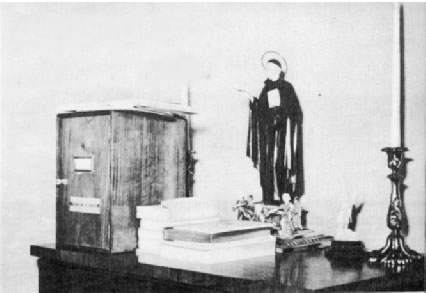
Soon after it became known that Pope Pius XII had personally taken custody of at least part of these documents. A journalist for the magazine Paris-Match, Robert Serrou, was permitted to do a photo-story on the Papal apartments, on May 14, 1957. He was shown around by the Pope's German housekeeper, Mother Pasqualina. Mr. Serrou saw a small wooden safe on a table, bearing the inscription Secretum Sancti Officii (Secret of the Holy Office). When he asked her what it was, Mother Pasqualina replied, "The Third Secret of Fatima is in there…"
Numerous Church authorities promised that the "Third Secret" would indeed be revealed in 1960, including Cardinal Cerejeira of Portugal and Vatican Cardinals Ottaviani and Tisserant. But Pope Pius XII died in October of 1958. When 1960 came, an expectant world was told that John XXIII had decided not to comply with "Our Lady's wishes." A Vatican press release, dated February 8, stated: "Faced with the pressure that has been placed on the Vatican, some wanting the letter to be opened and made known to the world, others, on the supposition that it may contain alarming prophecies, desiring that its publication be withheld, the same Vatican circles declare that the Vatican has decided not to make public Sister Lucia's letter, and to continue keeping it rigorously sealed.
"The decision of the Vatican authorities is based on various reasons: 1. Sister Lucia is still living. 2. The Vatican already knows the contents of the letter. 3. Although the Church recognizes the Fatima apparitions, she does not pledge herself to guarantee the veracity of the words which the three little shepherds claim to have heard from Our Lady.
"In these circumstances, it is most probable that the Secret of Fatima will remain, forever, under absolute seal. (A.N.I.)"
"Father, the Most Holy Virgin is very sad because no one has paid any attention to Her message, neither the good nor the bad. The good continue on their way but without giving any importance to Her message. The bad, not seeing the punishment of God actually falling upon them, continue their life of sin without even caring about the message. But believe me, Father, God will chastise the world and this will be in a terrible manner. The punishment from Heaven is imminent. Father, how much time is there before 1960 arrives? It will be very sad for everyone, not one person will rejoice at all if beforehand the world does not pray and do penance. I am not able to give any other details because it is still a secret. According to the will of the Most Holy Virgin, only the Holy Father [Pope Pius XII] and the Bishop of Fatima [Da Silva] are permitted to know the Secret, but they have chosen not to know it so that they would not be influenced. This is the third part of the Message of Our Lady, which will remain secret until 1960.
"Tell them, Father, that many times the most Holy Virgin told my cousins Francisco and Jacinta, as well as myself, that many nations will disappear from the face of the earth. She said that Russia will be the instrument of chastisement chosen by Heaven to punish the whole world if we do not beforehand obtain the conversion of that poor nation.
"Father, the devil is in the mood for engaging in a decisive battle against the Blessed Virgin. And the devil knows what it is that most offends God and which in a short space of time will gain for him the greatest number of souls. Thus, the devil does everything to overcome souls consecrated to God, because in this way, the devil will succeed in leaving the souls of the faithful abandoned by their leaders, thereby the more easily will he seize them.
"That which afflicts the Immaculate Heart of Mary and the Heart of Jesus is the fall of religious and priestly souls. The devil knows that religious and priests who fall away from their beautiful vocation drag numerous souls to Hell. ...The devil wishes to take possession of consecrated souls. He tries to corrupt them in order to lull to sleep the souls of lay people and thereby lead them to final impenitence" (La verdad sobre el Secreto de Fatima, Fr. Joaquín Alonso).
On March 17, 1990, Cardinal Silvio Oddi, who had been a close friend of John XXIII, declared that the Third Secret "...has nothing to do with Gorbachev. The Blessed Virgin was alerting us against apostasy in the Church" (Il Sabbato, March 17, 1990).
In a personal letter to a Professor Baumgartner of Salzburg, Austria, Cardinal Luigi Ciappi revealed: "In the Third Secret it is foretold, among other things, that the great apostasy in the Church begins at the top" (Catholic, March 2002).
Many were surprised, therefore, when on June 26, 2000 the Vatican revealed what it claimed was the genuine Third Fatima Secret; for the text of this version of the secret was not a message from Our Lady. Rather it was the purported description of a further vision granted to the three children at the July Apparition. The Vatican then attempted to interpret the vision and to put the whole matter to rest. That didn't happen. Immediately critics began to voice their suspicions, and a flood of evidence began to emerge. The criticisms and the evidence fall into three general categories: 1) that the "vision text" is a complete fraud; 2) that the "vision text" may be valid, but its interpretation by the Vatican is bogus; 3) that the "vision text" may be valid, but the Vatican is covering up the existence of a further text—the words of Our Lady explaining the vision and linked to the words, "In Portugal, the dogma of the Faith will always be preserved; etc."
Sr. Lucia had always maintained that the Secret of Fatima has three parts. But does the Third part have two parts? The evidence that it does began as early as 1952, when Pope Pius XII sent an Austrian Jesuit, Fr. Joseph Schweigl, to question Sr. Lucia in her convent at Coimbra. After the interview, which took place on September 2, Fr. Schweigl stated: "I may not reveal anything with regard to the Third Secret, but I am able to say that it has two parts: One part concerns the Pope. The other part is the logical continuation—though I may not say anything—of the words: 'In Portugal, the dogma of the Faith will always be preserved etc.' "
Indeed, that the Third Secret contained the words of Our Lady, had already been revealed by Fatima expert Canon Casimir Barthas, after his interview with Sr. Lucia concerning the Third Secret on October 17-18, 1946. Barthas had stated: "The text of the words of Our Lady was written by Sister Lucia and enclosed in a sealed envelope." But the Vatican's version of the Third Secret contained no words of Our Lady!
Cardinal Ottaviani also interviewed Sr. Lucia concerning the Third Secret, in 1955. He later revealed (in 1967): "She wrote on a sheet of paper what Our Lady told her to tell the Holy Father." It is a well-known fact that Ottaviani had by this time read the Third Secret himself, and could not possibly be mistaken. So where is this paper with the words of Our Lady for the Holy Father?
Third Secret Controversy—Part II
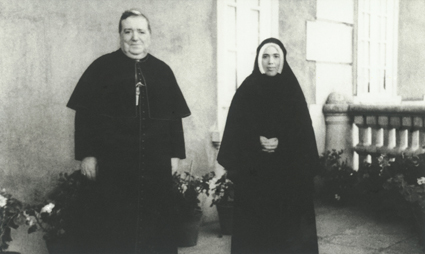
Sister Lucia with Bishop da Silva in 1946
Were there Two Sister Lucias?
This kind of topic is rather unsavory in itself, as it invokes memories of silly conspiracy theories, including one, some years ago, that featured photo enlargements of the ears of Paul VI. It would not be worth mentioning in this Series, were it not for the fact that some rather serious-minded sources are suggesting that the Vatican II Era Sr. Lucia was not the same person as Pre-Vatican II Era Sr. Lucia. The theory, if it were true, would explain a lot of difficulties encountered by those who believe the entire Third Secret of Fatima has not yet been divulged publicly. It would explain why Sr. Lucia apparently never complained about this. It would explain the absurd "confession" which Sr. Lucia was supposed to have made about the "1960 date." It would explain why the Vatican II Era Sr. Lucia seemed so carefree and lighthearted, while the Pre-Vatican II Era Sr. Lucia was always seen to be so grave and concerned. But therein lies the danger—one might give too much credence to the evidence out of a sense of preference, rather than on its merits. One might prefer to believe it, and therefore assume too much.
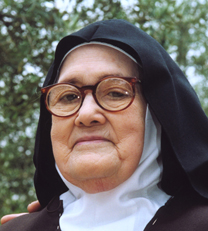 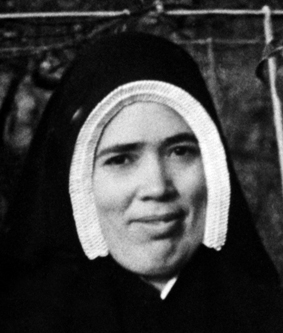 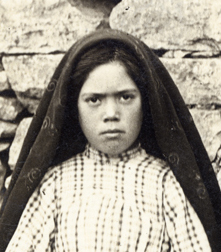 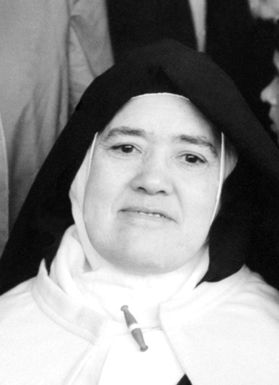 | ||
In 1967, no one thought to question whether these two photos were of the same person. They seemed similar enough.
|
(Left) Sr. Lucia in 1946. Is this the same person as the 1967 "Sr. Lucia"?
(Right) "Sr. Lucia" in 2000. Does she match 1967, 1946, or both? | |
With this danger clearly in mind, we intend to give a well-balanced view of the photographic evidence, together with scientific opinion on the subject of facial aging.
The reasoning behind the theory runs thus: Sr. Lucia was a Dorothean nun when she revealed the first two Secrets, together with the existence of the Third. Some years later, in 1948, she obtained permission to practice her religious life in a strict cloister. She was sent to the Carmel of Coimbra, where, naturally enough, she was seldom photographed. She did not emerge into public view until 1967, at the celebrations for the 50th Anniversary of the apparitions. Then she appears somewhat different from the photos of her taken only 20 to 25 years previously. But no one noticed this, because the older photos were practically unknown—only photos of her as a young girl at the time of the apparitions had been widely distributed. So the thinking is that a switch was made to avoid conflict over the Third Secret, presumably in the early 1960';s. There have been claims that the real Sr. Lucia died—even that she was murdered—around the year 1960, but there has been no substantial evidence to back up those claims. So we will examine here only the theory that there were two Sr. Lucias: a pre-1960 "Sr. Lucia I" and a post-1960 "Sr. Lucia II."
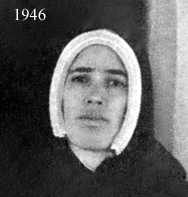
We begin with the short verbal description of Sr. Lucia's appearance, made by the author William Thomas Walsh after he had interviewed Sr. Lucia in 1946: "[Lucia's teeth] were large, projecting and irregular, causing the upper lip to protrude and the heavy lower one to hang, while the tip of her snub nose turned up more than ever. Sometimes her swarthy face suggested a nature that could be sullen, stubborn and defiant, if not perverse. But the appearance was deceptive, for under the stimulus of any emotion, the light brown eyes could flash or twinkle, and the little dimples that creased her cheeks when she smiled contributed to an expression quite charming." (Our Lady of Fatima, p. 11)
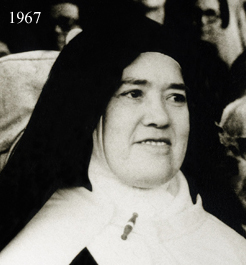
Next we have the points of difference noticed in an article (The Two Lucys—Photos and Facts) by Dr. Marian T. Horvat, which we have extracted and numbered, so that they may more easily be compared with scientific comment. We are omitting several points which appear to be too subjective. To be perfectly fair we are also omitting nearly all the photos provided by Dr. Horvat, which compare the 1946 Sr. Lucia with the "Sr. Lucia" of advanced age only, not the 1967 photos. We do provide photos from the official Fatima website (it is not known, however, whether any of these photos have been altered).
1) "The natural line of the thick, heavy eyebrows of Sister Lucy I is straight. The brows extend into the forehead area above her nose and past the inner corner of her eyes. The eyebrows of Sister Lucy II... are not straight, but slightly arched and taper off; the arch begins directly over the eye. There is a broad space without brows above the nose between the two eyebrows."
2) "When Sister Lucy I smiles, her upper cheeks appear like two small round apples. Although the cheeks of Sister Lucy II are partially covered by her large glasses, it seems clear she lacks these bulges."
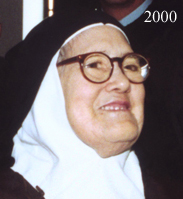
3) "I could not find any photo of Sister Lucy I, smiling or serious, with her nostrils open. They do not flare naturally. All the photos of Sister Lucy II, however, show her with her nostrils flaring. They open naturally"
4) "Under the apple cheeks of Sister Lucy I are definite dimple creases... But the cheeks of Sister Lucy II are flat and broad, with no creases or dimples when she smiles."
5) "In his description of Sister Lucy, Walsh also notes her protruding upper lip and 'heavy lower one' that hangs. The two lips have different widths. The lips of Sister Lucy II, however, are flat, thin, tight and of an equal width."
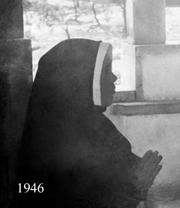
6) "When Sister Lucy I smiles, the ends of her mouth point upward. But when Sister Lucy II smiles, the ends of her mouth point downward."
7) "Another distinguishing feature of Lucy as a child that can be seen in her photos up to age 40 is a protuberant muscle in the middle of her chin, pronounced enough to form a dimpled area underneath. But this muscle never appears in the photos of Sister Lucy II."
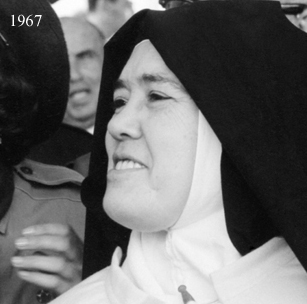
8) "Sister Lucy I's chin is strong but not salient. On the contrary, the chin of Sister Lucy II is a prominent chin. The latter has a square jaw, which does not appear in the photos of Sister Lucy I— The chin of Sister Lucy I, even though she is younger and not overweight, recedes sharply into her neck, with the tendency to disappear into a double-chin. However, the chin of Sister Lucy II, although she is older and heavier, juts forward and outward. It is so prominent that it forms a kind of platform extending out further than her nose." That it really extends further than the nose does not appear to be true of all the photos, such as that on the right.
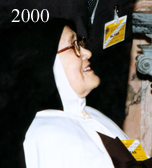
9) "...the profile of her (Sister Lucy I's) nose... aptly fits the description of Walsh, who noted that 'the tip of her snub nose turned up.' However, the nose of Sister Lucy II is rounded at the tip, pointing slightly downward."
10) "Sister Lucy I has very long and bad teeth... It is not indisputable that Sister Lucy II is wearing dentures... No one replaces bad and ugly teeth by anther set of bad and ugly teeth... In addition, since dentures are artificial, they never change their appearance. But at times Sister Lucy II's gums seem inflamed... at other times her gums seem to retract... And if these are the natural teeth of Sister Lucy II, then they are clearly different from the natural teeth of Sister Lucy I. In that case, how can it be explained except that we are looking at two different persons?" Dr. Horvat did not include a 1967 photo, as we do below. There the 1967 photo (middle) shows nearly perfect teeth.
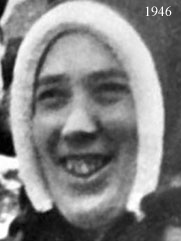 | 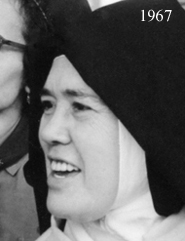 | 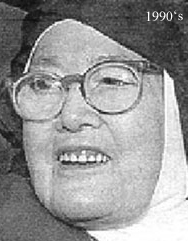 |
Long, bad teeth; perfect teeth; short, bad teeth. The center and right photos can perhaps be accounted for if they are of natural teeth, shortening with age and affected by gum disease. But then, how explain the teeth on the left?
| ||
Now we look at scientific opinion, extracted from an article by FBI agents Michael A. Taister and Sandra D. Holliday and Forensic Odontologist H.I.M. Borman (Comments on Facial Aging in Law Enforcement Investigation, Forensic Science Communications, April 2000, Vol. 2, No. 2). We will include numbers to reference the extracts numbered above. Wrinkling of the skin is not an issue here.
"Evidence of biological aging usually appears between the ages of twenty and thirty... Lines around the mouth... become apparent, and lines from the edge of the nose to the lateral part of the mouth will progressively deepen. With the onset of these changes there may also be a hollowing of the cheek area below the... cheekbone...(2, 4, 6) Men and women of middle age may display thicker, bushier eyebrows than in their younger years... (1—the opposite is seen in the photos.)
"More general age-related trends affecting the appearance and profile of the face include the increasing prominence of the chin (8), the decreasing convexity of the skeletal nose (9), and the lengthening of the upper and lower lips (5). These trends are particularly evident from birth until age eighteen, but their effects are seen, though less dramatically, into adulthood and beyond. With increasing age, the skeletal profile of the human face begins to lose its distinctive, protuberant appearance as changes in the shape and orientation of the nasal bone lead to a flattening of the facial features (2, 3, 4, 6, 7). At the same time, however, the soft tissue facial profile trends towards greater convexity with progressive age, demonstrating that the musculature and skin of the head and face do not always follow the development of the underlying bony tissue (1, 2, 4, 7).
"When a person loses teeth... the demand for support in the bone surrounding the teeth will be decreased. This leads to a resorption of bone in those areas of disuse... The presence of less bony tissue in the upper jaw decreases the height of the face and causes the lower jaw to appear more prominent (8).
"Replacement of the natural teeth with dentures may inhibit the continued resorption of bone in the upper and lower jaws to some extent, but a change in the density if not the physical thickness of the bone tissue in the jaws will usually be apparent."
Women will tell us that eyebrows thin with advanced age (1) and that lips lose their pucker (5). So given all of the above, it seems that nearly all of the differences noted by Dr. Horvat could possibly be accounted for by aging. Although it must be admitted that the difference in the chin and jaw between 1946 and 2000 is very pronounced, this could also be accounted for by differences in posture. The earlier photos showing a receding chin may be due to the head and neck being held back, in a more youthful attempt at "good posture." If the head were also slightly bent down, the chin would also be drawn back somewhat. In the later pictures, the head and neck may be slouching forward, with the head tilted up, thus tending to jut the chin out.
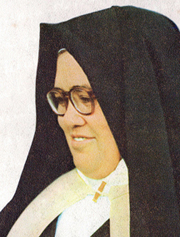
The image on the right shows the cover of a book published in 1976 (Fatima in Lucia's Own Words); but the cover photo was supposed to have been taken in 1963. Here Sr. Lucia is somewhat obese and wears glasses. Her head is bent slightly down, so her chin does not jut out. Her teeth appear to be straight, but this is far from clear. It is quite possible that she was asked to lose weight and forego wearing her glasses for the public appearance in 1967. There are definitely differences between this and the 1967 photos, but they do not seem conclusive.
The indisputable difference is the teeth. What possible scenario can account for the dental differences, not just between the 1946 and 1967 photos, but also between both of them and the circa 2000 photos? We here examine a few:
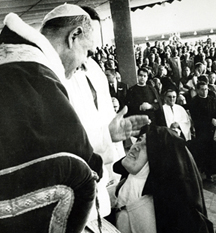
Scenario 1: Sr. Lucia had her bad teeth fixed with major dental surgery or complete dentures before 1967. This might also explain other facial differences, like the chin and jaw. But then how do we explain the short teeth and gum problems of the later photos? Did she have her first, nice dentures replaced with bad ones? If she did not receive full dentures, but only partials or crowns, could her teeth end up looking as they do in the circa 2000 photos—evenly worn?
Scenario 2: Sr. Lucia of 1967 is the same person as 1946, but not the same as 2000. This is highly unlikely, since the 1967 Sr. Lucia is closer in appearance to the 2000 Sr. Lucia.
Scenario 3: Sr. Lucia of 1967 and of 2000 are the same person, with natural teeth, which were worn with age and affected by gum disease. But then the long, crooked teeth of Sr. Lucia of 1946 must be explained. That she had those long, crooked teeth straightened with braces and filed to make them even would explain it. But why? Would a cloistered nun really have cosmetic dental work done?
Scenario 4: They are two different sets of teeth, because they are two different people. How could the real Sister Lucia, who saw Hell, go along with the Vatican II cover-up of Our Lady's Secret?
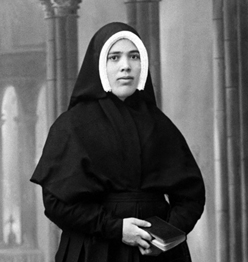
Third Secret Controversy—Part III
The Suppression of the Third Secret
Some very critical things have been said about Pope Pius XII by certain authors, accusing him, for instance, of aiding the suppression of the Third Secret by ordering all the Fatima documents to be sent to Rome in 1957. However, there is no hard evidence that this was done to suppress the Secret. There were repeated indications during the time of Pope Pius XII that the Third Secret would indeed be revealed in 1960. Again, some have criticized Pope Pius XII because, they say, he did not read the Secret when invited to do so by Sister Lucia. But there is no hard evidence for this assumption either. The fact that it has been reported that the envelope (or one of them) was still sealed after the death of Pope Pius XII proves nothing. Even wax seals are easily resealed, and it would have been imprudent to leave such envelopes unsealed.
All the hard evidence concerning the suppression of the Secret points to one person: John XXIII. To understand clearly the history of the suppression, however, one must look to an event which occurred near the end of the Pontificate of Pope Pius XII. This was the publication of an interview conducted by Fr. Augustín Fuentes with Sister Lucia. Fr. Fuentes was the postulator of the cause of the beatification of the Fatima visionaries, Francisco and Jacinta Marto. He spoke with Lucia on the day after Christmas of 1957. The conversation was published, with ecclesiastical approval, in the United States in 1958 in the magazine, Fatima Findings, and again on June 22, 1959, in the Portuguese daily, A Voz. Poor Fr. Fuentes was to pay dearly for his zeal. Let us see what it was that occasioned such a firestorm of reaction after the death of Pope Pius XII.
Sr. Lucia's Interview with Fr. Fuentes, Dec. 26, 1957
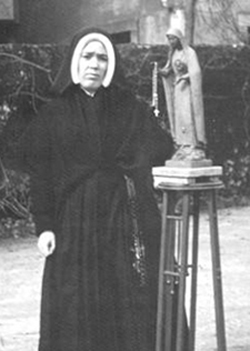
It should be noted that this interview took place only three weeks after the death of Bishop da Silva on Dec. 4, 1957. It is easy to understand that Sr. Lucia was very much saddened, not only by the death of her Bishop, but by his apparent failure to read the Third Secret, in spite of her urgings to do so. But her anxiety obviously goes much further than that. We have already given an excerpt from this text in the first part of this series. Here is the entire text, with Fr. Fuentes giving his comments in italics:
"I wish only to tell you about the last conversation which I had with Sister Lucia on the 26th of December last year. I met her in her convent. She was very sad, very pale and emaciated. She said to me:
"Father, the Most Holy Virgin is very sad because no one has paid any attention to Her message, neither the good nor the bad. The good continue on their way but without giving any importance to Her message. The bad, not seeing the punishment of God actually falling upon them, continue their life of sin without even caring about the message. But believe me, Father, God will chastise the world and this will be in a terrible manner. The punishment from Heaven is imminent.
"Father, how much time is there before 1960 arrives? It will be very sad for everyone, not one person will rejoice at all if beforehand the world does not pray and do penance. I am not able to give any other details because it is still a secret. According to the will of the Most Holy Virgin, only the Holy Father and the Bishop of Fatima are permitted to know the Secret, but they have chosen not to know it so that they would not be influenced.
"This is the third part of the Message of Our Lady, which will remain secret until 1960.
"Tell them, Father, that many times the most Holy Virgin told my cousins Francisco and Jacinta, as well as myself, that many nations will disappear from the face of the earth. She said that Russia will be the instrument of chastisement chosen by Heaven to punish the whole world if we do not beforehand obtain the conversion of that poor nation..."
"Sister Lucia also told me: Father, the devil is in the mood for engaging in a decisive battle against the Blessed Virgin. And the devil knows what it is that most offends God and which in a short space of time will gain for him the greatest number of souls. Thus, the devil does everything to overcome souls consecrated to God, because in this way, the devil will succeed in leaving the souls of the faithful abandoned by their leaders, thereby the more easily will he seize them.
"That which afflicts the Immaculate Heart of Mary and the Heart of Jesus is the fall of religious and priestly souls. The devil knows that religious and priests who fall away from their beautiful vocation drag numerous souls to Hell. ...The devil wishes to take possession of consecrated souls. He tries to corrupt them in order to lull to sleep the souls of lay people and thereby lead them to final impenitence. He employs all tricks, even going so far as to suggest the delay of entrance into religious life. Resulting from this is the sterility of the interior life, and among laypeople, coldness (lack of enthusiasm) regarding the subject of renouncing pleasures and the total dedication of themselves to God.
"Tell them also, Father, that my cousins Francisco and Jacinta sacrificed themselves because in all the apparitions of the Most Holy Virgin, they always saw Her very sad. She never smiled at us. This sadness, this anguish which we noted in Her, penetrated our souls. This sadness is caused by the offenses against God and the punishments which menace sinners. And so, we children did not know what to think except to invent various means of praying and making sacrifices...
"The other thing which sanctified my cousins was to see the vision of Hell.
"Father, that is why my mission is not to indicate to the world the material punishments which are certain to come if the world does not pray and do penance beforehand. No! My mission is to indicate to each one of us the imminent danger we are in of losing our immortal souls for all eternity if we remain obstinate in sin."
"Sister Lucia also said to me: Father, we should not wait for an appeal to the world to come from Rome on the part of the Holy Father, to do penance. Nor should we wait for the call to penance to come from our bishops in our diocese, nor from the religious congregations. No! Our Lord has already very often used these means, and the world has not paid attention. That is why now it is necessary for each one of us to begin to reform himself spiritually. Each person must not only save his own soul but also help all the souls that God has placed on our path...
"The Devil does all in his power to distract us and to take away from us the love for prayer...
"Father, the Most Holy Virgin did not tell me that we are in the last times of the world, but She made me understand this for three reasons.
"The first reason is because She told me that the Devil is in the mood for engaging in a decisive battle against the Virgin. And a decisive battle is the final battle where one side will be victorious and the other side will suffer defeat. Also from now on we must choose sides. Either we are for God or we are for the Devil. There is no other possibility.
"The second reason is because She said to my cousins as well as to myself that God is giving two last remedies to the world. These are the Holy Rosary and devotion to the Immaculate Heart of Mary. These are the last two remedies, which signify that there will not be others.
"The third reason is because in the plans of Divine Providence God always, before He is about to punish the world, exhausts all other remedies. Now, when He sees that the world pays no attention whatsoever, then, as we say in our imperfect manner of speaking, He offers us 'with a certain trepidation' the last means of salvation, His Most Holy Mother. It is 'with a certain trepidation' because if you despise and repulse this ultimate means we will not have any more forgiveness from Heaven because we will have committed a sin which the Gospel calls the sin against the Holy Ghost. This sin consists of openly rejecting with full knowledge and consent, the salvation which He offers. Let us remember that Jesus Christ is a very good Son and that He does not permit that we offend and despise His Most Holy Mother. We have recorded through many centuries of Church history the obvious testimony which demonstrates, by the terrible chastisements which have befallen those who have attacked the honor of His Most Holy Mother, how Our Lord has always defended the honor of His Mother."
"Sister Lucia told me: The two means to save the world are prayer and sacrifice.
"Regarding the Holy Rosary, Sister Lucia said: Look, Father, the Most Holy Virgin, in these last times in which we live, has given a new efficacy to the recitation of the Holy Rosary. She has given this efficacy to such an extent that there is no problem, no matter how difficult it is, whether temporal or above all, spiritual, in the personal life of each one of us, of our families, of the families of the world, or of the religious communities, or even of the life of peoples and nations that we cannot resolve through the recitation of the Rosary. There is no problem, I tell you, no matter how difficult it is, that we cannot resolve by the prayer of the Holy Rosary. With the Holy Rosary we will save ourselves. We will sanctify ourselves. We will console Our Lord and obtain the salvation of many souls.
"Finally, devotion to the Immaculate Heart of Mary, Our Most Holy Mother, consists in considering Her as the seat of mercy, goodness and pardon and as the sure door through which we are to enter Heaven." (La Verdad sobre el Secreto de Fatima, Fr. Joaquín Alonso).
The Chastising of Fr. Fuentes
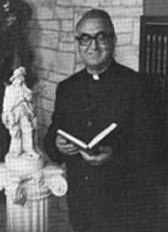
Between the first publication of this interview in Fatima Findings, and the second in A Voz, Pope Pius XII had died and John XXIII had begun his plans for Vatican Council II—the council of "no condemnations." Nevertheless, on July 2, 1959, the Chancery of Coimbra published an extremely harsh, but anonymous, condemnation of Fr. Fuentes:
Father Augustín Fuentes, postulator of the cause of beatification for the seers of Fatima, Francisco and Jacinta, visited Sister Lucia at the Carmel of Coimbra and spoke to her exclusively about things concerning the process in question. But after returning to Mexico, his country—if we can believe an article in A Voz of last June 22, and a translation by M. C. de Bragança published on July 1 by the same journal—this priest allowed himself to make sensational declarations, of an apocalyptic, eschatological and prophetic character, which he declares that he heard from Sister Lucia's very lips.
Given the gravity of such statements, the chancery of Coimbra believed it its duty to order a rigorous investigation on the authenticity of such news which persons too avid for the extraordinary have spread in Mexico, in the United States, in Spain, and finally in Portugal.
For the peace of mind of those who have read the documentation published in A Voz and have taken alarm at the thought of fearful cataclysms which, according to such documentation, are to come upon the world in 1960, and still more, in order to put an end to the biased campaign of "prophecies," whose authors, perhaps without realizing it, are provoking a storm of ridicule, not only where they themselves are concerned, but also with regard to things reported as having been said by Sister Lucia, the Diocese of Coimbra has decided to publish these words of Sister Lucia, given in answer to questions put by one who has the right to do so:
"Father Fuentes spoke to me in his capacity as Postulator for the causes of beatification of the servants of God, Jacinta and Francisco Marto. We spoke solely of things connected with this subject; therefore, whatever else he refers to is neither exact nor true. I am sorry about it, for I do not understand what good can be done for souls when it is not based on God, Who is the Truth. I know nothing, and could therefore say nothing, about such punishments, which are falsely attributed to me."
The chancery of Coimbra is in a position to declare that since up to the present Sister Lucia has said everything she believed it her duty to say about Fatima, she has said nothing new and consequently has authorized nobody, at least since February 1955, to publish anything new that might be attributed to her on the subject of Fatima."
Fr. Fuentes was literally being accused of lying, and Sr. Lucia appeared to be confirming the accusation! But Fr. Fuentes was not without his defenders. Archbishop Manuel Lopez of Veracruz maintained that Fr. Fuentes "had preached nothing that would contradict the message of Fatima, nor had he attributed frightening prophecies to Sr. Lucia." The Archbishop of Guadalajara, Cardinal José Garibi y Rivera, also insisted that Fr. Fuentes "had predicted nothing terrible in his preachings." Indeed the text quoted above, while it contains serious warnings, makes no specific prophecies. Sr. Lucia merely reminds us that the "punishment from Heaven is imminent" and lists the reasons for which she believes we are in the "last times." So what was the Chancery of Coimbra referring to?
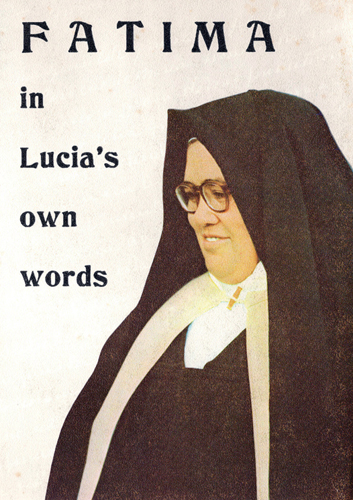
Fr. Fuentes was replaced as postulator by Fr. Louis Kondor, who reportedly took this photo of Sr. Lucia
for the cover of her soon-to-be-published memoirs in April, 1963 -- less than 5½ years after Fr. Fuentes
described her as "sad, very pale and emaciated."
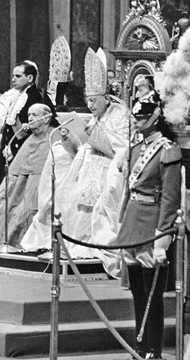
In spite of the efforts of his defenders, Fr. Fuentes was soon relieved of his functions as postulator for the cause of beatification for Francisco and Jacinta Marto, a decision which surely had to have come from John XXIII. After all was not Fr. Fuentes—and Sr. Lucia for that matter (and Our Lady of Fatima Herself)—amongst the "prophets of doom" that John XXIII had denounced at the opening of Vatican II (see photo right)? There he had said, on October 11, 1962:
In the daily exercise of our pastoral office, we often have to listen, with sad ears, to the voices of persons who, though burning with zeal, are not overly endowed with a sense of discretion or judgment. In these modern times they see nothing but calamity and ruin. They say constantly that our era, in comparison with the past, is growing steadily worse; they behave as if they have learned nothing from history, the teacher of life. They act as if former councils were evidence of complete victories for the Christian ideal of life and for true religious liberty. We, however, are of a completely different opinion from those prophets of doom who are always forecasting disaster as though the end of the world were at hand. In the present development of human events, through which mankind appears to be entering a new order, one must, rather, discern a hidden plan of Divine Providence...
The truth about this shocking event would not come out until 1976. But he who revealed the truth would also pay a price.
Fr. Alonso—the Fatima Archivist
Fr. Joaquín Alonso had been entrusted by Bishop da Silva's successor, Monsignor Venancio, with the task of archiving and editing all of the documents concerning Fatima. Early on he had adopted the criticism of the Chancery of Coimbra concerning Fr. Fuentes. But by 1975, and after much painstaking research, he had completely reversed his opinion. In his work, published in English in 1976 as The Secret of Fatima: Fact and Legend, he tactfully revealed the truth:
Who was right in this lamentable affair? Father Fuentes, the Coimbra diocesan spokesman, or Lucia? We would like to offer an explanation, giving our own modest opinion:
1. What Father Fuentes says in the genuine text of his conference to the Mexican religious community... (in May of 1958) corresponds no doubt in its essentials to what he heard during his visit to Sister Lucia, for although the text is mingled with the preacher's own oratorical embellishments, and although it is adjusted to conform to a literary pattern, these texts say nothing that Sister Lucia had not said in her numerous published writings. Perhaps the principle defect lay in the presentation of these texts as coming from Lucia's own mouth, and formally and expressly given as "a message from her" addressed to the world. Sister Lucia did not have this intention.
2. The genuine text, the only one that can be justly attributed to Father Fuentes, does not, in my opinion, contain anything that could give rise to the condemnatory notice issued from Coimbra. On the contrary, it contains a teaching most suited to edify the piety of Christians.
3. The diocese of Coimbra, and through it Sister Lucia, have made no distinction between the genuine text which alone can be justly attributed to Father Fuentes, and the vast "documentation" to which we have already referred. An error of judgment was thus committed, for everything was included in one single all-embracing condemnation.
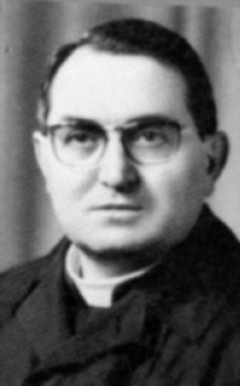
In other words, Fr. Alonso was tactfully suggesting that Sister Lucia was shown some false documents (probably articles from the journal A Voz) which led to her statement of denial, if indeed the statement is even genuine. In the same work Fr. Alonso also gave his opinion on the probable contents of the Third Secret:
If 'in Portugal the dogma of the Faith will always be preserved,' ...it can be clearly deduced from this that in other parts of the Church these dogmas are going to become obscure or even lost altogether.
Thus it is quite possible that in this intermediate period which is in question (after 1960 and before the triumph of the Immaculate Heart of Mary), ...the text makes concrete references to the crisis of the Faith within the Church and to the negligence of the pastors themselves,... [to] ...internal struggles in the very bosom of the Church and of grave pastoral negligence by the upper hierarchy,... [and] ...deficiencies of the upper hierarchy of the Church.
Could Fr. Alonso have been referring to John XXIII and Vatican II? By this time Fr. Alonso had also finished his massive work, Fatima Texts and Critical Studies, consisting of 24 volumes of some 800 pages each. He referenced and archived 5,396 documents in this result of his ten years of research. However, the "upper hierarchy" would not let such criticism go by unnoticed. The new "bishop" of Leiria-Fatima, Alberto do Amaral, forbade the publication of the 24 volumes entirely! It was only after the death of Fr. Alonso, that two highly edited volumes were published. Apparently silencing the Third Secret itself was not enough.
Roncalli vs. Our Lady of Fatima
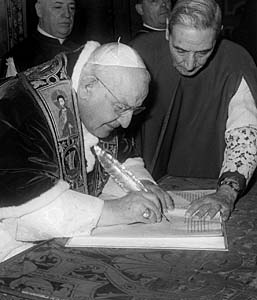
Msgr. Capovilla, who has provided the best evidence for the existence of a second text of the Third Secret, has also provided us with a blow-by-blow account of the decision of John XXIII to suppress the Secret. On October 28, 1958—less than three weeks after the death of Pope Pius XII—Sr. Lucia, perhaps fearing what was to come, put aside her usual reserve and asked for permission to deliver a radio message to the world! In early January of 1959, a meeting was held to discuss this and the Third Secret. Cardinal Cento, who had brought the Third Secret to Rome in 1957, told Roncalli: "It is well that you take a look at it. Sr. Lucia has approached me. She could deliver a message to the world. I do not know if it is opportune..." Roncalli's answer: there would be no radio message; instead great restrictions were to be placed on the communications of Sr. Lucia. Eventually she was not permitted to speak to anyone (with very few exceptions) without the Vatican's permission.
On January 25, 1959, John XXIII was again advised to read the Third Secret immediately. But he decided to wait until he had announced the convocation of Vatican II (see photo left). Did he perhaps fear that the Third Secret contained a warning about the very thing he was determined to do? It was not until August 17 that he would read the Secret. Capovilla gives the details: "[John XXIII] after having spoken with everyone [the collaborators he had consulted] told me: 'Write.' And I wrote under his dictation: 'The Holy Father had received from the hand of Msgr. Phillipe this writing. It was decided to read it on Friday with his confessor. There being abstruse locutions, he called for Msgr. Tavares, who translated. He allowed his most intimate collaborators to see it. It was finally decided to reseal the envelope with this phrase: I do not give any judgment.' Silence before something that could or could not be a manifestation of the divine."
There followed, on February 8, 1960, the anonymous press release, from which we have already quoted in the first part of this Series. It would be good to recall here these words of the press release: "It is very probable that the letter in which Sr. Lucia wrote the words of the Virgin Mary addressed to the three shepherds at the Cova da Iria, will never be opened." After all that we have seen in this Series, these words become a glaring contradiction—for the "vision text" published in 2000 is not a letter and it contains no words of the Virgin Mary!
It is also worth noting that, at Vatican II, John XXIII invited two Russian Orthodox observers to be present, with the assurance that the Council would not formulate any condemnation of Communism or the Soviet system. "The initiative for the meetings (to make this unholy accord) was taken personally by John XXIII at the suggestion of Cardinal Montini..." (Roman Amerio, Iota Unum, 1985). After the silencing of Sr. Lucia and Our Lady of Fatima, who warned specifically that "Russia would spread her errors...", this action of Roncalli and Montini is seen to be all the more deliberate—and sinister.
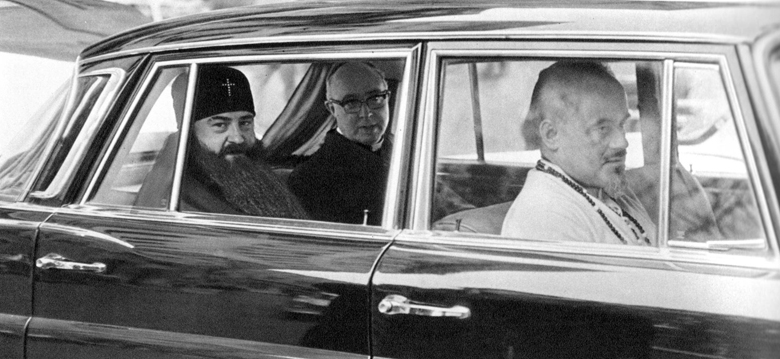
There having been no condemnation of Communism or the Soviet system -- in accordance with the assurance made by John XXIII and the future Paul VI -- Russian Orthodox "Metropolitan" Nikodim arrives in Rome with John XXIII's agent, Msgr. Willebrands, and Fr. Pierre Duprey from the "Secratariat for Christian Unity," for the last day of Vatican II.
The Third Secret Controversy—Part IV
The Testimony of Msgr. Silvio Oddi
Silvio Oddi, ordained a priest on May 31, 1933, was a Vatican diplomat, mostly in the Middle East, from 1938 to 1962. In spite of his reputation as a "conservative," he was named "cardinal" by Paul VI in 1969, and became a member of the "curia" from 1979 until his retirement in 1985. Statements which he made in interviews granted in 1990, as well as in his Memoirs, published in 1995, have shed much light on the Third Secret Controversy.
The first of these interviews was given for the "Catholic" journal Il Sabato, and published in its edition of March 17, 1990:
By now everyone acknowledges that Cardinal Silvio Oddi has one virtue that is extremely rare in the present-day ecclesiastical environment: the frankness and freedom with which he states his views. The interview which follows is one more proof of this. It has for its theme one of the enigmas that during this century has most moved the collective religious imagination: the Third Secret of Fatima. It is a matter which took on contemporary relevance again last month, following the publication in 30 DAYS of a letter from Sister Lucia, one of the three visionaries to whom the Mother of God appeared on May 13, 1917. Referring to the upheavals in eastern Europe, the Portuguese nun wrote: "I believe it is an action of God in the world from the danger of an atomic war that could destroy it." Many have seen in these words the confirmation that the Third Secret has something to do with the current developments in the USSR, as if the Virgin Mary had prophesied and mysteriously guided Gorbachev's plan of perestroika. This view has ended in attributing to these political events the miraculous character of a spiritual and religious rebirth.
ARE YOU ALSO OF THIS OPINION?
CARDINAL ODDI: No, on the contrary, I remain very skeptical. I believe I knew John XXIII quite well, since I spent a number of years at his side when he was at the nunciature in Paris. If the Secret had concerned realities consoling for the Church like the conversion of Russia or the religious rebirth of eastern Europe, I believe that he would have brought pressure to bear to make the Secret public. By temperament he did not hesitate to communicate joyful things (it has been revealed that Cardinal Roncalli in a number of letters to friends practically announced his election to the papacy). But when I asked him during an audience why in 1960, when the obligation to keep the secret had come to an end, he had not made public the last part of the message of Fatima, he responded with a weary sigh. He then said: "Don't bring that subject up with me, please ..."
DID YOU EVER SPEAK WITH SISTER LUCIA?
CARDINAL ODDI: Yes, in 1985. I had gone to Portugal to celebrate solemnly the anniversary of the apparitions, and I did not resist the desire to exchange a few words with her. Obviously I did not ask her to reveal the Secret to me but I asked her if she was aware of the reason why the Church had decided not to make it public.
AND SISTER LUCIA, WHAT DID SHE SAY?
CARDINAL ODDI: She said that in May 1982 she had spoken about it with John Paul II, who had made a pilgrimage to Fatima to render thanks to Our Lady a year after the attempted assassination in St. Peter's Square. Together they had decided that it was more opportune not to reveal the Secret. For fear, she explained to me, that it might be "misinterpreted." The same explanation, I am told, was given by the Holy Father during his visit to Germany. This attitude of the Church reinforced in me a theory that I had had for a number of years ...
AND WHAT IS THAT?
CARDINAL ODDI: What happened in 1960 that might have been seen in connection with the Secret of Fatima? The most important event is without a doubt the launching of the preparatory phase of the Second Vatican Council. Therefore I would not be surprised if the Secret had something to do with the convocation of Vatican II…
WHY DO YOU SAY THAT?
CARDINAL ODDI: From the attitude Pope John showed during our conversation, I deduced—but it is only an hypothesis—that the Secret might contain a part that could have a rather unpleasant ring to it... But we all know that... many sad things... took place in conjunction with the Council. I am thinking, for example, of the number of priests who have abandoned the priesthood: it is said that there have been 80,000 ...
AND WHAT IS YOUR ASSESSMENT OF ALL THIS?
CARDINAL ODDI: This: that I would not be surprised if the Third Secret alluded to dark times for the Church: grave confusions and troubling apostasies within Catholicism itself... If we consider the grave crisis we have lived through since the Council, the signs that this prophecy has been fulfilled do not seem to be lacking ...
Greater details were forthcoming in the November 11, 1990 edition of Trenta Giorni, an "international Catholic" monthly. Msgr. Oddi gave these details in "memoir" form:
Like the priests and all the faithful, I have become interested in the Third Secret of Fatima. As it is known that it was to be revealed in 1960 unless Sister Lucia had died earlier, we were all waiting for that year to arrive. But 1960 has come and gone, and nothing has been announced. As secretary to John XXIII when he was in Paris, I took advantage of the trust he placed in me to tell him frankly:
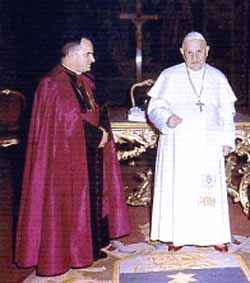
"Most Holy Father, there is one thing for which I cannot forgive you."
"What?" he asked.
"Having the world in suspense for so many years and then watching 1960 come; several months have gone by and nothing about the secret has been made known."
Roncalli answered: "Don't speak to me about this."
I replied: "If you don't want me to I will say no more, but I can't keep the people from doing so. The interest is spontaneous; I must have delivered a hundred sermons and speeches announcing the revelation."
"I told you not to speak to me about it anymore."
I didn't persist, but I wanted to get to the bottom of the story. Then I went to Msgr. Capovilla, his private secretary, and asked: "Have you opened the secret?"
"Yes, we opened it."
"Who was present?"
"There was the Pope"—he told me—"Cardinal Ottaviani, and I, but we couldn't understand it since it was handwritten and in Portuguese. So we called a Portuguese monsignor who worked in the Secretariat of State."
I, who knew John XXIII very well, am sure that the secret contained nothing good. Roncalli didn't like to hear about scandals or punishments. From that I conclude that it contained something about prohibition, punishment, or disaster...
At this point let me advance a hypothesis: that the Third Secret of Fatima pre-announces something terrible the (Vatican II) Church has done... something whose consequences were very painful, with a tremendous decline in religious practice. And that later, following a great suffering, the Faith would return. Yes, this may be the content of the secret. But if this were true, the fulfillment of the secret has already been observed, for the crisis in the Church is visible to all. And the most alert souls recognized it years ago.
As an example, Oddi lamented the travesty that had taken place in Assisi—the pan-religious "prayer meeting" of 1986:
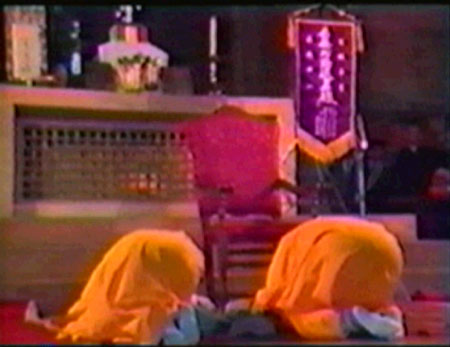
On that day, I went to Assisi as the Pontifical Legate for the Basilica of St. Francis, and I saw true profanations in some places of prayer. I saw Buddhists dancing around the altar, on which they had put Buddha in the place of Christ, and they were burning incense to the Buddha and venerating it. A Benedictine protested—he was thrown out by the police. I did not protest, but my heart was scandalized. Confusion was apparent on the faces of the Catholics who were attending the ceremony. I thought: if at this moment the Buddhists were to distribute bread consecrated to Buddha, these people would be capable of agreeing to eat it, perhaps with a greater devotion than when they receive the (Novus Ordo) host.
Lastly, Msgr. Oddi summed up his position on the Third Secret in his book of memoirs, Il Tenero Mastino di Dio, published in 1995:
The prophecy of Fatima was completely defied! It is a lack of sense, I would say, because according to the interpretation that seems to me most worthy of consideration, the Third Secret—which John XXIII and his successors thought inopportune to reveal—is not about a supposed conversion of Russia, still far from becoming a reality, but regards the "revolution" in the (Vatican II) Church. From (this) Council… so many innovations were born that they appear to constitute a true internal revolution.
In conclusion to this series, it is amazing to note that, after 10 years of denial, Ratzinger has begun to reverse his position on the Third Secret. In 2000, Ratzinger had maintained steadfastly that the Third Secret regarded the past: "No great mystery is revealed; nor is the future unveiled."
But on his flight bound for Fatima, on May 11, 2010, Ratzinger was asked by a journalist whether the Third Secret might have something to do with the current sexual abuse scandal. Ratzinger replied: "Beyond the great vision... there are indications of the reality of the Church's future..." It should be noted that questions from journalists like this are pre-screened by the Vatican.
Two days later, on May 13, 2010, Ratzinger included this in his homily at Fatima: "We would be mistaken to think that Fatima's prophetic message is complete."
Was it more double-speak, or a change in policy? The mystery, as we have noted before, continues......




Comentários
Postar um comentário